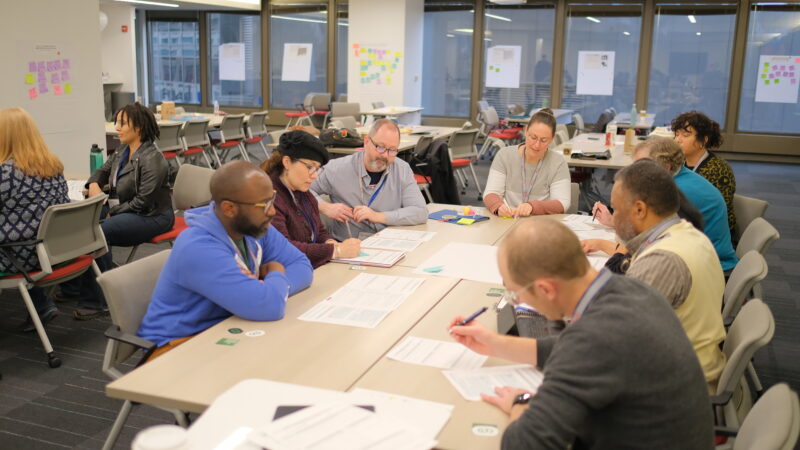Communicating Trusted Election Information series
A six-course series on getting accurate info to voters

What you’ll need
- Computer with internet access to watch the courses online
- Colleagues whose responsibilities include communications, both online and offline
Getting started
About this series
A major task for any elections office is communicating trusted election information to voters and the media. Additionally, communicating your needs and priorities with other public officials is often necessary to get you the resources and support you need to run excellent elections. This series of recorded courses and companion materials brings together best practices, tools, and ideas from research on effective communication, experts in the field, and the work of election officials across the country to help you improve your office’s communications.
Target audience
- Election officials and communications staff who oversee or handle their office’s communications with voters, the media, or public officials
- Others looking for an overview of the full scope and impact of election communications
Courses
Explore all six courses or choose the ones most relevant to your work. Some content will build on other courses in the series, but each course stands alone as a useful resource.
1. Improving Your Election Website
Completing this course will help you:
- Identify the top civic information people are looking for online
- Apply principles of plain language and design to your website
- Prioritize digital methods for building trust with your voters
2. Accessible Communication for Election Offices
Completing this course will help you:
- Learn the principles of accessible communication and how they increase public trust
- Understand how people with disabilities experience information online
- Establish actionable guidelines for making your website more accessible
3. Social Media for Voter Engagement
Completing this course will help you:
- Review what research tells us about how voters look for election information
- Know how to use social media to build trust with voters year-round
- Implement basic design principles to create engaging graphics
4. Combating Election Misinformation
Completing this course will help you:
- Get familiar with terms and concepts related to information operations
- Identify different forms of misinformation, malinformation, and disinformation and how to respond
- Develop resilience with a defensive communications strategy
5. Educating and persuading public officials
Completing this course will help you:
- Confidently inform policymakers about how you administer elections
- Establish and maintain trusted relationships with public officials
- Get involved in initiatives advancing practical and voter-centric policies
6. Working with the media
Completing this course will help you:
- Make the most of media coverage to educate voters
- Counter misinformation, disinformation, and malinformation in the press
- Develop productive relationships with credible journalists
Using the tool
Taking the course
On the course series page, you will find all of the videos and other materials for each course. Some options and materials you may find useful:
- Captions are available for each course. On the bottom control panel of the embedded video, you can turn on captions by clicking on the square with “CC” in it, to the right of the video progress bar.
- Chapters are another useful feature on the bottom control panel. These let you jump to particular sections of the course without needing to watch the rest or skip over sections that might not be applicable to the work you are focusing on. You can access the list of chapters by clicking on the symbol with three stacked dots and lines.
- Slides are available for download in the links below the associated video. You can keep a copy of the presentation slides for later reference or print out the slides and make notes on them as you listen to the course.
- Participant guides are another downloadable option beneath the videos. These cover each section of the course material in similar depth as the videos. Like slides, you can download and print them for later reference or make notes on them as you listen to the course. If you prefer to read than listen, participant guides are a great way to learn the content of the course. They also include links to sources and resources mentioned in the presentation.
- Generic templates that are discussed in the courses are also available for download in the links beneath the videos. These can be a great way to get started on something new you learn about!
Sharing what you learn
The more you and your coworkers learn together, the more likely you are to be successful. To get others involved in your office, try a few of these approaches.
- Share at a staff meeting. Each time you complete a course, write out your biggest takeaways. Add a short section to an upcoming meeting agenda where you can share what you learned with your coworkers.
- Invite a coworker to take the course with you. Two (or more) heads are better than one! If you share responsibilities for your office’s communications work, invite teammates to register for the courses. Schedule time to check in as you work through the series and cheer each other on!
- Offer a resource. The courses highlight numerous tools — from social media calendar templates for election offices to automated website accessibility checkers to structures for writing op-eds and more. If it’s appropriate, share information about the resources with others in your office or area who might appreciate it.
Earning credit
Many states, state associations, and public service credentialing programs offer credit for taking courses with the Center for Tech and Civic Life. To find out if these recorded courses are eligible, consult the governing body for your program. For a certificate of completion, contact support@ElectionExcellence.org
Customizing for your officeCustomizing for your office
Any tips for customizing this resource for my office?
This series presents tools, generic resources, and strategies which may be suitable for a variety of offices. Some courses explicitly call out where tools, generic resources, or strategies may be particularly applicable for a jurisdiction based on size, resources available, language communities, and more.
How do I know if this resource is helping?
This series should offer some new tools, generic resources, and strategies for improving your communications with voters, the media, and public officials. Ideally, the resource should spark some new ideas for how to better communicate trusted election information across multiple platforms and in varied settings, and make your staff engaged in communications work feel more confident and capable in their work.
Which Standards of Excellence does this resource support?
- Plain language
- Information design
- Language access
- Voter communications
- Community relationships
- Media relationships
Which Values of Excellence does this resource support? Why?
Values for the U.S. Alliance for Election Excellence define our shared vision for the way election departments across the country can aspire to excellence. These values help us navigate the challenges of delivering successful elections and maintaining our healthy democracy.
Alliance values are nonpartisan and designed by local election officials, designers, technologists and other experts to support local election departments.
You may find this tool especially helpful for this Value:
- Voter-centricity. These courses will help you provide accessible, trusted information to voters that will empower them to fully participate in elections by informing them of important election procedures, dates, and deadlines.
- Proactive transparency. Effective communication with voters, the media, and public officials is key to building trust in the election process. These courses will help you in designing and implementing public education campaigns on your work and respond to misinformation about elections in your community.
To learn more about the Values for Election Excellence, and to see the full list, visit the Alliance website.
Sharing FeedbackSharing Feedback
How was this resource developed?
This resource has been developed based on research from election experts and case studies from election offices around the U.S. Share your experience with this resource and improve it for your peers by reaching out via support@ElectionExcellence.org
How do I stay in touch?
- For the latest news, resources, and more, sign up for our email list.
- Have a specific idea, piece of feedback, or question? Send an email to support@ElectionExcellence.org


